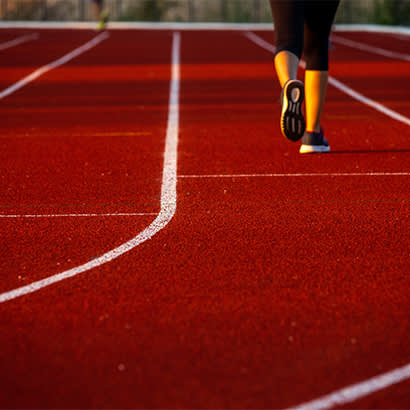
For an enhanced digital experience, read this story in the ezine.
One way communities can support people who want to get and stay healthy is by providing opportunities for an active lifestyle. The best options are easy and accessible to all ages and abilities, since according to America Walks, “less than 50 percent of youth and 24 percent of adults get enough physical activity.” Walking is a great option that offers benefits for all ages, supporting both physical and mental health, without the need for any special skills or equipment.
To promote walking, communities can integrate walking tracks in schools and public recreation facilities. Even though no special equipment is needed, the type of track material does make a difference. The best choice considers the track’s overall functionality and durability along with the walker’s comfort and safety. Tracks can be constructed using a variety of materials, like asphalt or concrete, but synthetic track systems offer multiple advantages.
Engineered for the Optimal Health and Enjoyment of Users
Synthetic urethane and acrylic floor systems have become the most common type of track installed around the world and a standard for major athletic competitions. These are designed based on performance standards for different activities, taking into account factors like durability and shock absorption to help keep users healthy. Adequate shock absorption reduces stress on joints and lowers risk for short- and long-term injury.
Community walking tracks are a versatile amenity, fit for a range of activities for competitions, avid walkers and families. It’s easy to physically distance and still maintain relationships and healthy interactions for virtual runs and walks. Indoor tracks with temperature-controlled environments are especially popular for year-round physical activity. Indoors or outdoors, tracks help residents develop more regular walking routines, as well as offer alternative environments that are safe and away from traffic.
Durability and Ease of Maintenance for Inside or Outside Tracks
Since walking is an any-season sport, durability and ease of maintenance are critical to keeping tracks consistently accessible. Synthetic urethane and acrylic tracks are preferred for their durability, resistance to weathering and relatively low maintenance required to retain an even surface. They’re also spike resistant. In contrast, natural materials like concrete, asphalt or wood chips require constant upkeep to fill holes and level the surface, especially after inclement weather.
Synthetic urethane and acrylic track systems offer a seamless and non-porous surface that makes them easier to keep clean and sanitary. There are no grout and cracks where germs and harmful bacteria can saturate or hide. Plus, they resist odors and don’t absorb sweat. A variety of coatings are available for proactive resistance to fungus and bacterial growth.
Adding a walking track to your educational sports or community recreation area encourages an active wellness culture in your community and helps make it a better place to live for everyone. Work with an experienced athletic floor system contractor to review the specifics of your location and identify the best synthetic urethane and acrylic track system that’s enjoyable for all. Let’s get walking!
Cory Corullo is the Director of Synthetic Sales at Action Floor Systems, LLC (cory@actionfloors.com).

